- Camping Tips
- Hiking Tips
- RV Camping
- Destinations
- Blog
- Gear Reviews
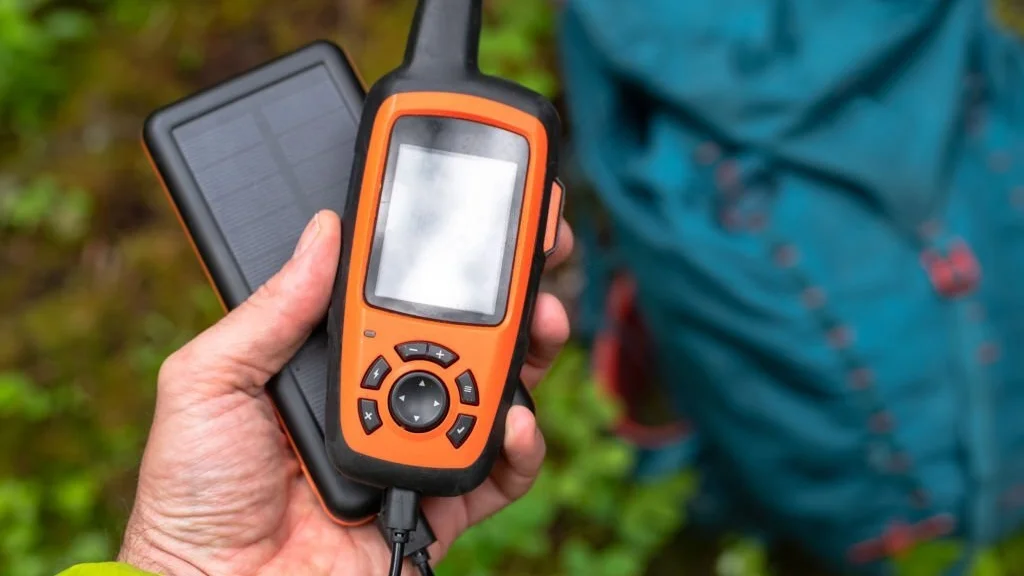
Spending time outdoors often means unplugging from our screens and taking in the sights and sounds of nature. Well, at least that is what diehard survivalists and outdoor enthusiasts advocate for. However, today’s reality is that we can barely function without our devices.
These devices are lifesavers when it comes to calling for help, navigating the backcountry, getting on-the-road work done, passing time during camping downtimes, or just taking photos. This brings up the next undying complication – these devices are constantly running out of juice!
Lucky for you, there are plenty of portable sources of power that you can use to recharge your devices.
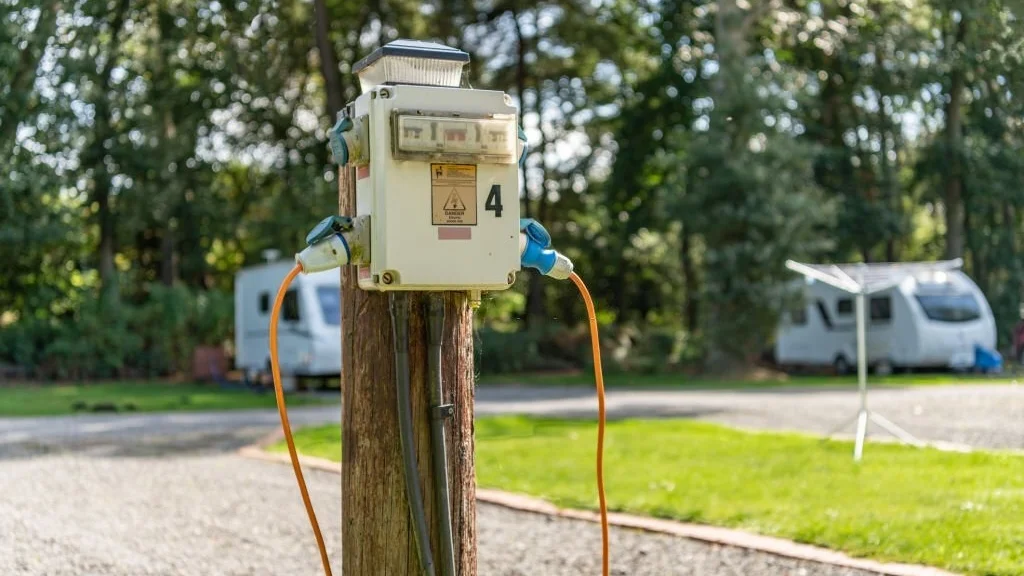
When your devices run out of juice, one of the easiest ways to recharge them is by plugging them into an electrical outlet. But where to find an outlet in the great outdoors? you ask. Well, you’ve got about two main options.
Firstly, you want to pick a campsite that has electrical hook-ups. Most campgrounds will provide a similar voltage as the one you use at home. However, it is always advisable to double-check with the site management if there are any power restrictions to avoid tripping the system.
And of course, be sure to pack a power strip, a wall charger, and some charging cables before stepping out of the door.
Next, community centers or some spaces in urban areas might allow you to recharge your devices. This might include community centers, cafes, or requesting your campervan or RV camping neighbors for a power boost.
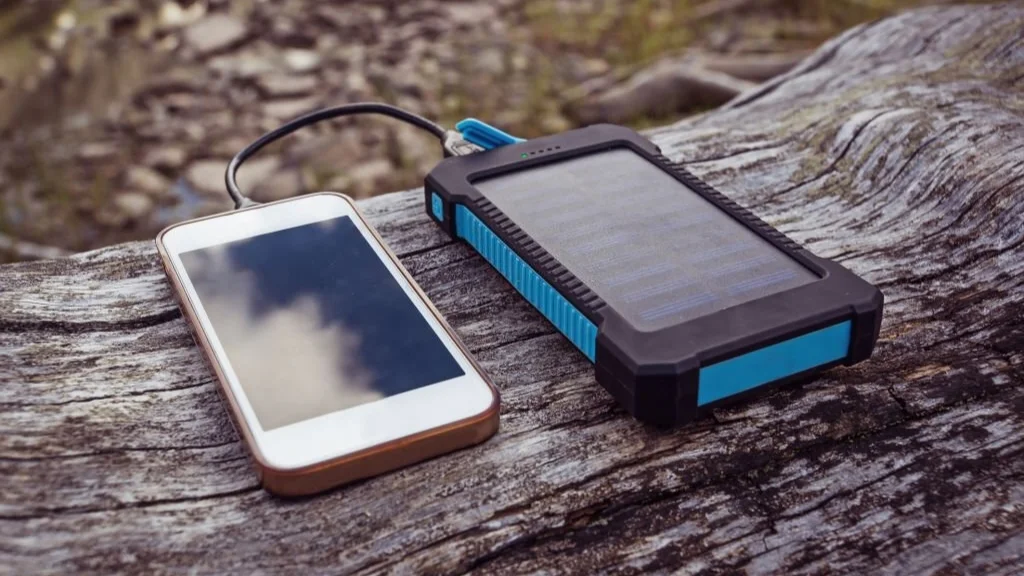
The use of a rechargeable power supply is arguably a more practical solution for recharging your devices. You can recharge them while in transit without an immediate reliance on an electrical outlet.
Some devices such as GPS gadgets and flashlights are typically powered by non-rechargeable batteries. For these types of devices, carrying extra batteries would ensure they remain functional throughout your camping trip. Laptops, smartphones, tablets, and other power-hungry devices will require more efficient solutions.
Broadly, we can group rechargeable power supplies into three major buckets:
Power banks or power packs come in a wide variety of styles and capacities. They mainly work for recharging smartphones, smartwatches, and other lower-capacity devices. Some of the factors to consider when shopping for a power bank include its capacity, size and weight, and partly its shape and style.
Here, the capacity of the power bank should be the key concern given that you will be using the power supply outdoors. The battery capacity for power banks is typically specified in milliamperes Hour (mAh). Put simply, the mAh unit represents the amount of stored energy in the given battery.
Power banks will commonly have capacities ranging from 3,000mAh to over 20,000mAh, which can either allow a single charge or multiple charges, respectively. For some context, most smartphones have batteries of just under 3000mAh. So, a 20000mAh power bank will easily charge multiple devices at least twice.
The size and weight of the power bank normally increase with the mAh capacity. A higher-capacity power bank might not be very comfortable to hold in your hand or easy to fit in your pockets. However, it will most likely fit snugly in your backpack’s side pockets or tent’s stash pockets.
The overall design of the power bank might not be an issue for most people especially if it will live in your backpack. Perhaps the most practical design we’ve seen is those phone cases that come with an inbuilt battery pack.
That said, if you don’t mind the hunt, there are plenty of sleekly designed and less boxy power banks in the market waiting for you.
Battery capacities in most notebook laptops range from 2000mAh to 6000mAh. So, if you will be bringing a laptop along with other devices then a power bank just won’t cut it. That’s where a portable power station comes in…
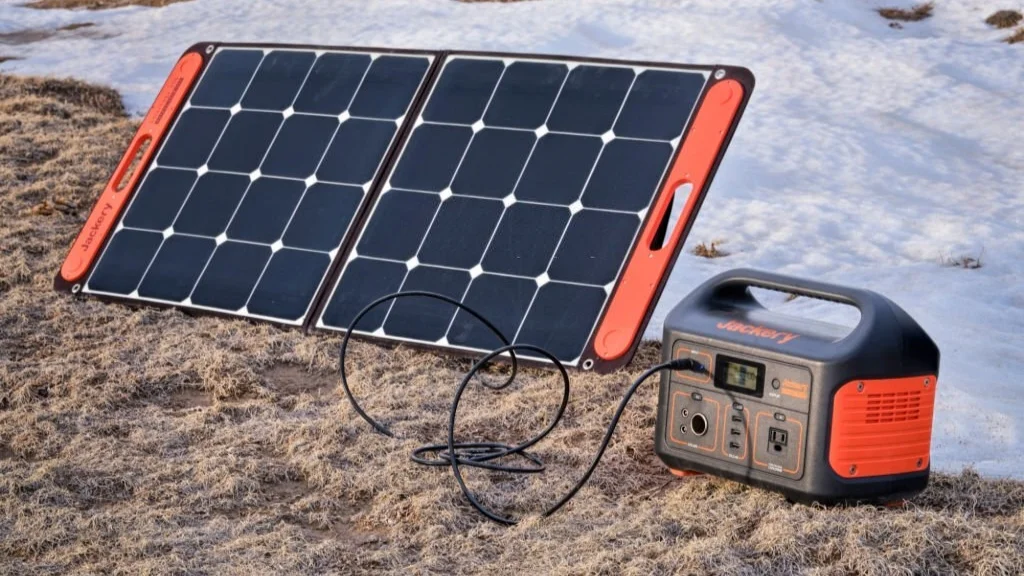
Put simply, a portable power station is just a bigger battery backup that you can use to power your electronics. It is powerful enough to not only recharge most of your portable devices and power your camp lights but also run some home appliances and tools.
Though they are most comparable to gas generators, portable power stations are slightly more advantageous. They are much safer than combustion-reliant generators, arguably affordable, considerably less bulky, and easier to use.
The main disadvantage of portable power stations is that they need to be recharged after the battery depletes. This process can take a very long time.
The key factors to consider when buying a portable power station include the battery type, battery life, power output, size, weight, and available charging ports.
The battery capacity in portable power stations will most likely be indicated in Watt-hours (Wh) instead of milliampere-hour (mAh). Watt-hour is just the amount of power used over one hour. A higher Watt hour rating translates to longer battery life and more power for using a powerful device.
Lithium-ion batteries are the popular option for these types of rechargeable power supplies. However, Lithium iron phosphate (LiFePo4) batteries are far superior to Lithium-ion ones. LiFePo4 batteries are more stable, long-lasting, economical, and offer good density.
Portable power stations usually take in power from solar panels, car 12V DC sockets, utility power, or in some cases, wind and hydro chargers.
Most portable power stations have integrated wall plugs, USB ports, and cigarette lighter style plugs. That means recharging most of your devices or appliances won’t be that much of a hassle. You should always go for models with small display screens that show useful information like the remaining battery life.
Although they have the term in their name, the portability of these power supplies is a bit relative. Most models are comparably small and lightweight weighing about two or three pounds. However, car campers can easily take advantage of even bigger and more powerful models given their more capable means of transportation.
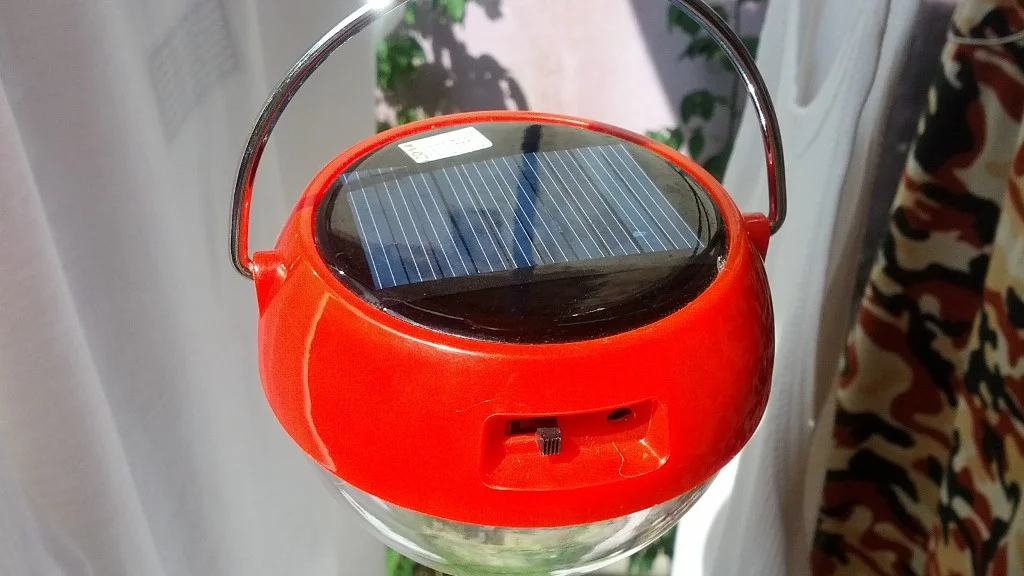
Less powerful than a power bank, these are some devices that double as chargers. Some portable speakers, lanterns, lamps, and flashlights come with integrated rechargeable batteries and charging ports.
They help you cut down your load and can be used to recharge smartphones, GPS devices, or other low-power devices. Since these two-in-one devices operate on the same power, they might not be the most efficient options.
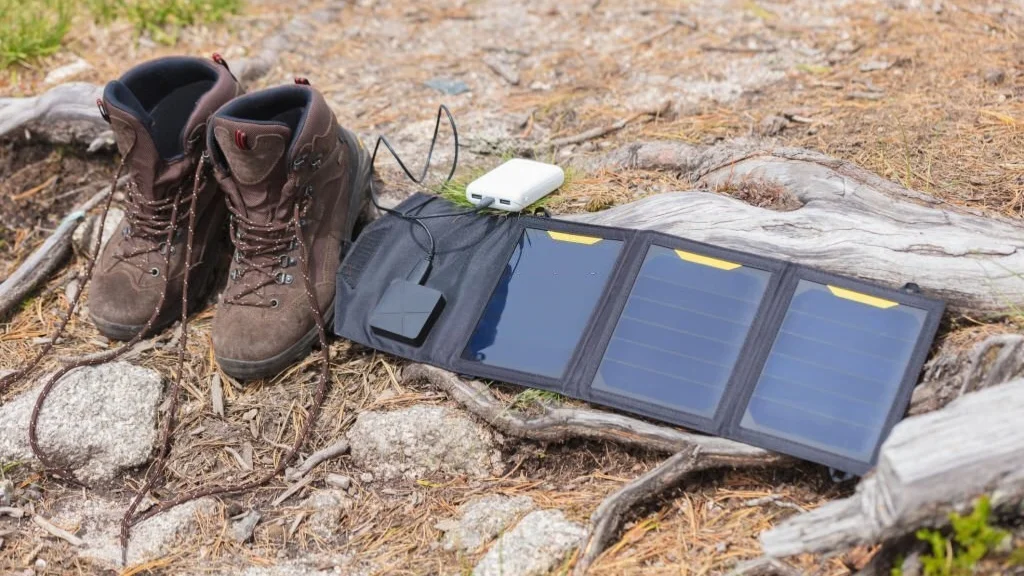
Solar chargers are your best bet for recharging your devices when on a multi-day boondocking adventure. They can be used as stand-alone systems or as complements to your rechargeable power solutions.
Whether you are a backpacker or a car camper, solar power chargers are designed for all types of campers. They will keep your devices charged as long as the sun is out. Some solar panels can be slapped on the car roof while others can be attached outside your backpack (solar backpacks) for on-the-go usage.
That said, the main let-down of these units is that they are highly dependent on the weather. Hiking through forests or scaling steep ascents will likely mean less exposure to direct sunlight for the solar panels. So, they work best during summer conditions and preferably where they are set up in the open.
Reliable solar power chargers can set you back a few dollars and the charging process requires a lot of patience. In addition, the included panels can sometimes be awkward to store away or stash away in your pack.
Primarily, a solar power charger is made of two components including solar panels and a charging system. The charging system should preferably include a battery to store the excess energy. But you can still find models that you can plug directly into.
When shopping for a solar charger, go for the one with more charging ports, slightly larger-surface panels, and a higher output capacity. Other go-to-have features on your ideal solar charger include foldable panels, kickstands, magnetic closures, longer cables, and attachment grommets.
Most cars and trucks already come with charging ports to help you recharge your devices. This can be done via the integrated cigarette lighter, USB ports, or wireless charging – all of which work fine for smartphones and tablets.
However, if you need more power for your laptops, cameras, or other devices such as laptops then you will need a power inverter. The inverter converts the car battery’s 12-volt direct current (DC) into a 110-volt alternating current (AC).
Wattage is the most important factor to consider when getting a car power inverter. Else, if you draw too much power from the battery then you might end up with electrical failures or a blown fuse. More devices will require an inverter with a higher wattage.
If you will be charging small-capacity devices, then you can just plug the inverter into the DC outlet. For more power, connect the inverter directly to the car’s battery. What you need to keep in mind is that pure sine wave inverters have a lower risk of damaging your device’s circuitry as compared to modified sine wave inverters.
The number of ports, surge protection, and a good quality build are some of the other features to consider when selecting a power inverter.
The main concerns of in-car charging include a heightened risk of draining the car battery and sometimes a harder installation process. Furthermore, you always want to use the power inverter and charge your devices when the engine is running. Else, the car battery will drain fast leaving you stranded at the campsite.
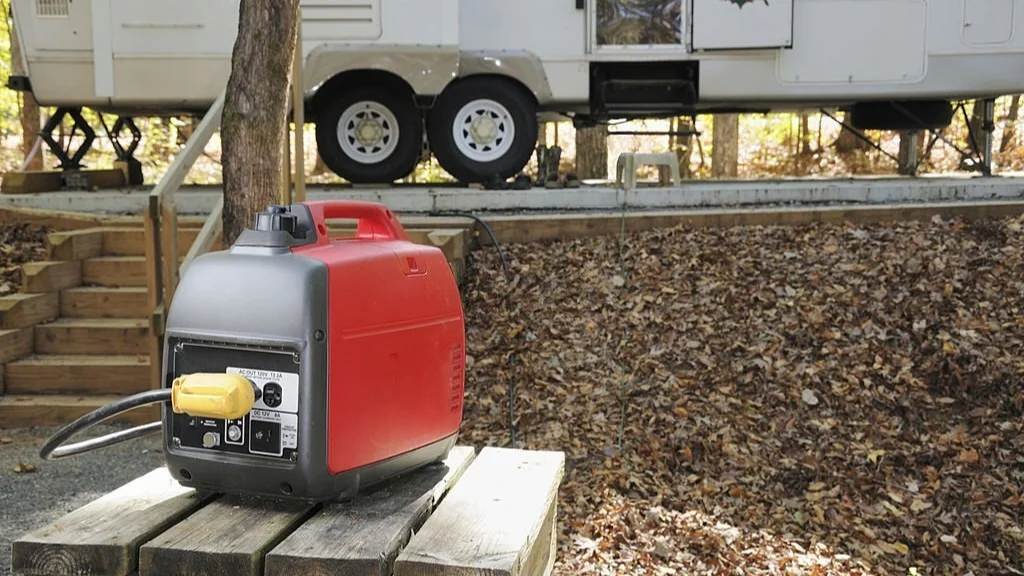
Generators have long been a necessity for RV camping. They are ideal for long camping trips in the backcountry and great for powering large appliances.
There are about three types of generators namely inverter, portable, and standby generators. Inverter and portable generators are the most applicable for camping since standby or backup generators are typically permanently installed in homes.
Portable generators are affordable and powerful enough to run large appliances. They use a combustion engine to generate electrical power but aren’t entirely portable as say, power banks or power stations. You will still need a car or truck to haul them from home to the campsite.
Inverter generators similarly use an engine to produce energy but it is done in three phases.
The engine first outputs AC power that’s then converted to DC and finally inverted to stable AC power. As a result, the power generated by an inverter generator is least likely to damage sensitive electronics such as laptops, televisions, and phones.
Apart from the type of generator, other major considerations when getting a camping generator include the power in watts, fuel options, noise levels, size and weight, and the number of outlets.
Most generators are powered by gasoline, which is commonly available. However, the use of gasoline itself poses a lot of challenges. These include it leaving gummy deposits in the fuel entryway as it evaporates over time and the gas going stale due to oxidation.
You want dual-fuel generators for your camping trips. Gasoline or propane (liquified petroleum gas) -powered generators can be solid options to consider. Conversion of some generators to run on LPG can also be done at a sensible price.
Higher wattage and a higher total runtime on a full tank of fuel are good tiebreakers when you can’t choose between your top picks. However, such high performance often correlates to a heftier, bulkier, and noisier generator.
Remember, some campgrounds have strict rules against noisy generators so you want your ideal option to operate just under normal conversation decibels. Any generator that operates below 60 decibels within 50 feet should be usable in most campsites.
In addition, your ideal camping generator should at least come with safety features such as low oil sensors, carbon monoxide sensors, and automatic shut-offs.
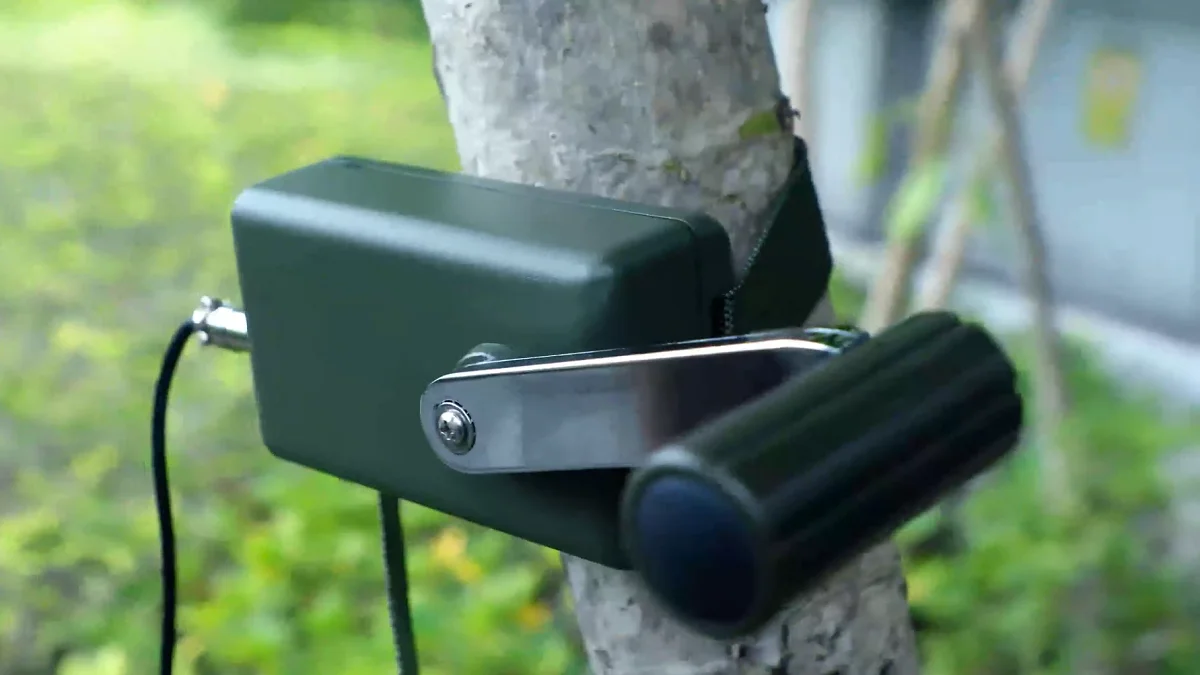
A return to more handheld alternatives, hand-crank and bike chargers are both super lightweight power options for charging your devices while camping. They both rely on you manually cranking or pedaling to generate electricity. If you want to see how one works, you can check out the 60-watt Powerhouse Charger.
Hand-crank devices might come bundled with other useful gear such as radios, flashlights, lanterns, or headlamps. However, it takes hard work and time to bring them to usable functionality so they are most applicable for emergencies.
NOAA weather radios with hand cranks are perhaps the best application of this idea.
Bike chargers might fully charge some phones after a 2- to 3-hour bike ride. So, if you take the bike-camping route, then they can be a worthy consideration for recharging your devices.

Technology has brought us ways to recharge devices with campfires. Your phone could be charging on the side while you sauté away your dinner. This is a good add-on to your other charging solutions and it could prove useful when camping in remote spots.
Some camp stoves are equipped with thermoelectric devices that convert thermal energy to electricity via the Seebeck Effect.
The BioLite CampStove is a good example of this, which goes a step further by storing the generated electricity in its built-in battery. You can plug in your phone while the fire is burning or later when the built-in battery has been fully charged.
Other fire chargers use fire-activated fuel cells to generate electricity in a process that mimics that of a plant’s photosynthesis. The VOTO Charger by Point Source Power works similarly.
That said, these fire chargers are only meant for charging phones and smaller devices as the power output is too low. They work best as secondary charging options when your rechargeable supply alternatives are unusable.
There are a few environmentally friendly portable turbines (like this one) that rely on wind or water to generate power. They are the perfect option for dispersed camping and in areas or seasons where solar alternatives are inapplicable.
However, these wind or water turbines work best with fast-flowing water and windy conditions. Additionally, they can cost a few more bucks than rechargeable options, and packing them down doesn’t always provide the best experience.

Firstly, you want to sum up the battery capacities of all the devices you will be bringing with you. This should include those of your camping party if you plan on sharing one power source. It stands to reason that the more devices you need outdoors, the more power you will require to keep them recharged.
These gadgets could include GPS devices, drones, cell phones, smartphones, laptops, tablets, and E-readers. Essentially, you want to go for portable power supplies that have capacities equal to at least the sum of the battery capacities of all your devices. That way, you can charge each of your devices at least once.
In addition, how long you intend to use the devices will further determine whether you can survive with just a power bank or a full-blown portable power station.
Perhaps you want to plan your route in a way that allows access to a wall charger at an as-needed pace. After all, most of the portable power solutions need to be recharged too after use. Further, the weight and size of your portable power supply may come into play depending on your camping style.
Lightweight and pocketable power banks may be best suited for backpacking and short camping trips. On the other hand, bulkier solutions like large battery packs with solar panels might be perfect for car campers.
The quick charging functionality can be found in select portable power systems. It helps cut down charging time, which can come in handy during short breaks while camping. In most cases, this feature results in more device usage, poor battery conservation, more charging cycles, and ultimately poor battery health.
So, you might want to let your devices slowly recharge when outdoors. Moreover, only some battery packs and power banks will give you decent fast-charging rates, unlike other portable power solutions.
Whether you are bringing a portable generator or a portable power station, there are a few methods you can implement to squeeze more battery life out of your devices. They mainly pertain to charging patterns and reduction of energy consumption in devices.
Although a bit counter-intuitive, you want to charge your devices whenever the opportunity arises. Charge them up before leaving the house and again don’t forget to bring the relevant wall chargers, charging cables, and power strip. You’d be surprised how many people leave these essentials at home.
Next, you don’t want to overcharge your device or expose it to extreme temperatures as that greatly degrades the batteries. You want to maintain the device’s battery between 20% and 80%-90% to help prolong its life. Therefore, partial charges would be more beneficial as opposed to full-cycle charges (0%-100%).
Extreme temperatures also degrade your device’s battery. So, you want to keep the devices warm during winter hikes and avoid leaving them out in the hot sun when camping in summer.
One of the best ways of reducing power usage in your devices is by using alternative devices that are better built for the task.
For instance, a digital camera is more reliable for photos instead of your smartphone. A compass and physical maps combo or a GPS device would probably be better suited for your navigation and wayfinding needs than using digital maps and GPS on your smartphone
Other ways to maximize the battery life of your devices include the following:
Note: Most of the battery-saving tips above apply to smartphones given our over-reliance on them but their application can be easily rolled over to other devices.
Being outdoors doesn’t always have to mean missing your homey comforts and devices. With the above power solutions and tips, you can enjoy using your devices at the campsite without worrying about them running out of juice.
However, your time outdoors shouldn’t be taken up with recharging devices or obsessing about the most efficient charging solutions. Remember to unplug and enjoy the great outdoors!
Charlie Leone
Website Owner/Editor
Welcome to CampingManiacs